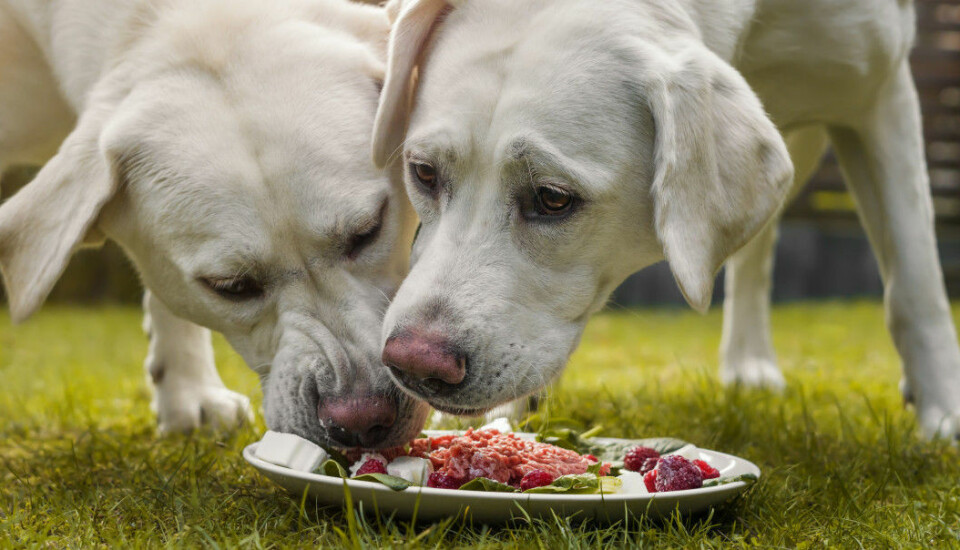
Is it okay to feed your dog leftovers?
ASK A RESEARCHER: Many dogs love to eat the same thing that we humans serve for dinner, but is it good for them?
Your dog looks longingly at your dinner plate. The lasagne seems heavenly, and the slice of buttered bread is also very tempting.
Dogs are very social, and many of our four-footed friends would like to eat at the same time as their owner, and preferably the same food, too. It can be easy to give in to their beseeching looks. Cats can also show the same interest in human food. As an expert on dog and cat nutrition, Professor Øystein Ahlstrøm at the Norwegian University of Life Sciences (NMBU) can explain what kinds of leftovers can be fed to your dog.
There are only a few foods that are dangerous for dogs to eat, so it’s relatively safe to give your dog leftovers now and then. You want to make sure that you’re not feeding your dog foods that are actually poisonous for them, such as onions, garlic and chocolate. Cats, in contrast, generally won’t eat foods that are unfamiliar.
Nevertheless, if you’re in the habit of feeding your dog leftovers, there are a few things that are good to know.
Commercial food meets a dog’s nutritional needs
Commercial dog food is designed to ensure that your dog gets all its nutritional needs covered at every meal. That makes it easy for owners to use this type of feed.
“If you think about people and how we eat, we almost never get all the nutrients we need in every meal. However, it doesn't matter as long as we eat balanced meals over the long run,” says Ahlstrøm.
This is also true for dogs. But they aren’t able to ensure on their own that their diet is balanced over time. That means if you feed your dog leftovers, you should give your dog less commercial dog food, so your dog doesn’t become overweight. You should also ensure that your dog’s diet is balanced over time, although Ahlstrøm says that it takes a lot for this to be a problem.
“If you can use up your leftover food by feeding it to your dog, I think that’s positive. You can also think about your dog’s diet in the same way as we do about our own diets. Think of proteins first and foremost, with less focus on carbohydrates and fat.
Unprocessed ingredients are a safe bet
Ahlstrøm recommends giving simple foods to your dog, if you want to give something extra. Leftover food should not constitute more than 25 per cent of the volume you feed your dog, unless you have specialized knowledge and are able to assemble your own complete food.
“If you stick to pure fish, meat and potatoes, for example, you are pretty sure not to make a mistake,” he said.
Chicken, fish and mince are rich in protein. Potatoes contain both protein and starch. Dogs can also eat vegetables, although they are easier to digest if they are cooked. Boiled eggs are also a good choice.
“A buttered slice of bread spread with liver pate contains many nutrients the dog needs,” Ahlstrøm says.
Nor is it dangerous for a dog to eat starchy foods, such as bread or cooked rice.
“Half of commercial dog food is grain, which contains a lot of carbohydrates,” Ahlstrøm says.
Vegetable and marine oils can be beneficial because they contain essential fatty acids.
Avoid spicy food
But what about brown sauce?
"Well," says Ahlstrøm. “Brown sauce contains spices.”
He also recommends keeping Indian dishes and tacos away from your dog’s bowl and avoiding spicy foods overall. The dog will not necessarily be harmed by eating this kind of food, but it may affect your dog's stomach.
“The simplest thing is to use pure raw materials,” he repeats.
Changes in poop patterns
Unhealthy foods can cause changes in a dog’s digestion, and consequently, the way it poops.
“It’s just like people. If one day we eat lamb and boiled cabbage and the next day something completely different, we’re likely to notice a difference in digestion. In a dog, however, this is seen as something negative,” he says.
The dog can develop loose stools, and will need to poop more often than usual.
“A dog that tends to poop twice a day suddenly has to go out three times, or at night. This can be negative, not for the dog necessarily, but for the owner who has to get up, or deal with a mess if the dog poops on a rug. So there are practical aspects to this,” he says.
Meat alone does not cover all nutritional needs
Bones are the main source of calcium and phosphorus for wolves and wild cats. These substances are especially important for animals that are growing. One of the most common mistakes to make when using homemade feed for puppies or kittens is to provide just meat or fish without bones or any other calcium source, says Ahlstrøm. An example might be cats who just want tuna from the can or a puppy that is fed only meat.
“A wolf will eat all of its prey, because it contains all the nutrients they need. We humans typically only eat muscle meat, which is what we think is good, but really the most nutritious parts of prey animals are the intestines, liver, kidneys, blood and brain, along with other bits that we don't usually eat. Wild predators also eat bones,” the researcher says.
Ahlstrøm says that in extreme cases where young pets are not fed properly, the lack of calcium can cause the body to absorb calcium from its own skeleton.
“I have heard of cases where someone has brought half-grown cats to the vet. The vet takes an x-ray and it looks like the animal has no skeleton. The lack of calcium has meant that the bones have no hard structures, which become soft so that they are not clearly visible in the picture,” he said.
Don't let your bad conscience take over
One disadvantage of feeding a dog leftovers may be that it becomes fussy and overweight.
“There is a danger that the dog will take over. When you sit down at the table, they lie down next to you like they’re playing a mind game. It can go so far that when you butter your bread, they’re ready to take the slice right out of your hand,” he said.
“It’s very important that you feed your dog in a controlled way, or they can take over and become tyrants,” says Ahlstrøm.

This is especially true if the owner has bad conscience. Maybe the dog has been alone a lot or hasn’t been walked enough lately.
“Many people feel that they can compensate for a bad conscience by giving the dog a little extra food,” he said.
Bones or no bones?
Giving the dog bones poses a risk. Bones may get stuck in the dog’s teeth or, in the worst case, bits can get stuck in the gut. Bones are hard to digest, and can give a dog diarrhoea or cause it to vomit. Still, many dogs are fine with chewing on bones. Dog breeds with short snouts and underbites may have problems with this, however.
The benefit of giving a dog bones is that they remove plaque and tartar. A study conducted by Ahlstrøm with a Brazilian researcher showed that dogs who got thigh bones from cattle had reduced the amount of plaque on their teeth by half after three days. The safest thing is to give beef bones, which are very hard and difficult for dogs to crush.
“Most dogs really like to get bones to chew on. Bones are different from regular food, they defend them from other dogs in a different way, and are happy to bury them. From an animal welfare standpoint, they are positive,” he said.
However, bones do pose a risk, so the dog owner has to decide, he says.
If you want to give your dog bones, Ahlstrøm recommends starting when the dog is young.
“Then they take it easy and just chew on it. If the dog is not used to getting bones and they realize that the dog owner does not want them to eat it, they may want to swallow big bites in a rush,” he said.
Avoid high fat foods
In an article from Danish videnskap.dk, Professor Charlotte Reinhard Bjørnvad warns against feeding your dog too much fat and unhealthy food such as leftovers from Christmas dinner.
Bjørnvad is affiliated with the Department of Clinical Veterinary and Animal Science at the University of Copenhagen.
“Dogs cannot tolerate major changes in their diets. They are at increased risk of diarrhoea and acute inflammation of the stomach if they are fed something they are not used to. A Christmas meal for them is like a trip to India for the rest of us,” she said.
She said high-fat food could increase the risk of the dog developing pancreatitis, which can be serious.
“There are large variations between dogs in terms of how much they can tolerate, but the best thing is not to give them high-fat foods,” Bjørnvad says.
But she also says there is nothing wrong with giving your dog some leftovers.
———
Read the Norwegian version of this article at forskning.no






























